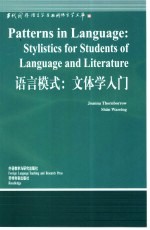

语言模式 文体学入门PDF电子书下载
- 电子书积分:11 积分如何计算积分?
- 作 者:(英)JoannaThornborrow,(英)ShanWareing著刘世生导读
- 出 版 社:外语教学与研究出版社;劳特利奇出版社
- 出版年份:2000
- ISBN:7560019889
- 页数:269 页
1 Introduction 1
1.1 About you… 2
1.2 What is stylistics? 3
1.3 Some debates about the methods and purpose of stylistics 6
1.4 The background to the study of language and literature 9
1.5 The purpose of this book 10
1.6 The structure of this book 11
Preface by Haliday 11
王宗炎序 12
导读 15
2 Sound and metre in peefry 15
2.1 Introduction 16
2.2 Sound patterning 17
2.2.1 Examples of sound patterning 17
2.2.2 Sounds versus letters 19
2.2.3 Syllable structure and sound patterning 25
Acknowledgements 28
2.2.4 Different forms of sound patterning 30
2.3 Stress and metrical patterning 32
2.3.1 Word stress 32
2.3.2 Stress in longerunits 34
2.3.3 Analysing metre 35
2.3.4 Different types of feet 36
2.3.5 Different types of metre 37
2.4 Conventiomal forms of metre and sound 38
2.5 The poetic functions of sound and metre 43
2.6 Analysis of poetry: checklist 45
Suggestions for furtherreading 47
3 Grammar and literary style 49
3.1 Introdwction 50
3.2 What is grammar? 52
3.3 Attitudes to grammar: prescription and description 52
3.4 Two levels of grammar: morphology and syntax 54
3.5 Word classes 58
3.5.1 Identifying word classes 58
3.5.2 Open and closed classwords 62
3.6.1 The noun phrase 64
3.6 Describing noun and verb phrases 64
3.6.2 The verb phrase 65
3.6.3 Non-finite verb phrases 67
3.7 Describing sentences 70
3.7.1 Simple and complex sentences 71
3.8 Foregrounding and grammatical form 75
3.9 Analysis of grammar: checklist 79
Suggestions for further reading 80
4 Meaning 81
4.2 Semantics 82
4.1 Introduction 82
4.2.1 Gaps and overlaps 83
4.2.2 Opposites 85
4.2.3 Hyponyms and superordinates 86
4.3 Context 88
4.3.1 Deixis 88
4.3.2 Homonyms 90
4.3.3 Other similar texts/discourses 90
4.3.4 Your prior knowledge 91
4.4 Register 92
4.5 Literal language and figurative language 95
4.5.1 Similes 95
4.5.2 Metaphor 96
4.5.3 Simile versus metaphor 98
4.5.4 Explicit and embedded metaphors 99
4.5.5 Types of metaphor 103
4.5.6 Metonymy 109
4.5.7 Synecdoche 110
4.6.1 New ideas or areas of knowledge 111
4.6 Metaphor and language change 111
4.6.2 Abstract ideas made concrete 112
4.7 Functions of figurative language use 112
4.8 Analysis of meaning: checklist 113
Suggestions for further reading 114
5 Stylistic applications to drama 115
5.1 Introduction 116
5.1.1 The significance of context 117
5.1.2 Drama on film 117
5.2 How should we analyse drama? 118
5.2.2 Drama as fiction 119
5.2.1 Drama as poetry 119
5.2.3 Drama as conversation 121
5.3 Differences between speech and writing 121
5.3.1 Pauses and pause fillers 123
5.3.2 Unclear speech 123
5.3.3 Repetition and recycling 124
5.3.4 Turn-taking 125
5.3.5 Back channel support 126
5.3.7 Discourse cohesion 127
5.3.6 Discourse markers 127
5.4 Analysing dramatic language 130
5.4.1 Turn quantity and length 130
5.4.2 Exchange sequences 130
5.4.3 Production errors 132
5.4.4 The cooperative principle 133
5.4.5 Speech acts 135
5.4.6 Presuppositions 136
5.4.7 Status marked through language 137
5.4.8 Register 139
5.4.9 Speech and silence-female characters in plays 141
5.5 Analysis of dramatic texts: checklist 142
Suggestions for further reading 143
6 From classic realism to modernism and postmodernism 145
6.1 Introduction 146
6.2 Literary perspectives on realist texts 147
6.3 The emergence of realism 152
6.4 Stylistic characteristics of realist texts 153
6.4.1 The omniscient narrator 154
6.4.2 Representation of place 157
6.4.3 Representation of Dialogue 158
6.4.4 Representation of time 161
6.4.5 Realism in other fictional genres 163
6.5 After classic realism 165
6.6 The origins of modernism 169
6.7 Stylistic characteristics of modernist texts 169
6.7.1 Language as a substance in its own right 170
6.7.2 Departure from conventional literary structures 170
6.7.3 Collage and allusion 171
6.8 The origins of postmodernism 172
6.7.4 Register 172
6.9 Stylistic characteristics of postmodernist texts 174
6.9.1 Language as a free-floating entity 174
6.9.2 Loss of narrative closure 175
6.9.3 Parody and pastiche 176
6.9.4 The and of cultural hierarchy 177
6.9.5 All stories have been told before 177
6.9.6 Self-feferentiality 178
6.9.7 Irony and humour 179
6.10 The function of style in fiction 180
6.11 Analysis of fiction: checklist 183
Suggestions for further reading 184
7 Style in popular texts 185
7.1 Introdnction 186
7.2 Exploiting patterns in sound and meaning: headline texts 187
7.3 Lexical creativity 189
7.4 Targeting the reader 190
7.4.1 Direct address in media texts 191
7.4.3 Presupposition in advertising 194
7.4.2 Addressing the listener 194
7.5 Reference and deixis 197
7.5.1 Deixis in advertising 199
7.5.2 Deixis in spoken media discourse 200
7.6 Transferring meaning: metaphors in advertising 201
7.7 Analysis of popular texts: checklist 204
Suggestions for further reading 206
8 Theory and style: next steps 207
8.1 Overview 208
8.2 Linguistics and literary criticism 209
8.3 Texts and the reader 211
8.4 Texts as discourse 212
8.5 Critical text analysis 213
8.6 Theory and practice: some further questions 215
8.7 Conclusions 216
Suggested answers to activities 217
Glossary 237
References 249
Bibliography 255
Index 261
文库索引 265
- 《HTML5从入门到精通 第3版》(中国)明日科技 2019
- 《少儿电子琴入门教程 双色图解版》灌木文化 2019
- 《区块链DAPP开发入门、代码实现、场景应用》李万胜著 2019
- 《Python3从入门到实战》董洪伟 2019
- 《程序逻辑及C语言编程》卢卫中,杨丽芳主编 2019
- 《幼儿园课程资源丛书 幼儿园语言教育资源》周兢编 2015
- 《高等学校“十三五”规划教材 C语言程序设计》翟玉峰责任编辑;(中国)李聪,曾志华,江伟 2019
- 《音乐语言的根基》张艺编著 2019
- 《小提琴入门新教程 第3册》王中男著 2018
- 《小提琴入门新教程 第2册》王中男编著 2017
- 《古代巴比伦》(英)莱昂纳德·W.金著 2019
- 《BBC人体如何工作》(英)爱丽丝.罗伯茨 2019
- 《一个数学家的辩白》(英)哈代(G.H.Hardy)著;李文林,戴宗铎,高嵘译 2019
- 《莎士比亚全集 2》(英)莎士比亚著,朱生豪等译 2002
- 《莎士比亚戏剧精选集》(英)威廉·莎士比亚(William Shakespeare)著 2020
- 《莎士比亚 叙事诗·抒情诗·戏剧》(英)威廉·莎士比亚著 2019
- 《亚历山大继业者战争 上 将领与战役》(英)鲍勃·本尼特,(英)麦克·罗伯茨著;张晓媛译 2019
- 《孩子们的音乐之旅 1 宝宝睡觉 幼儿版》包菊英主编 2016
- 《超级参与者》王金强责编;赵磊译者;(澳)杰里米·海曼斯,(英)亨利·蒂姆斯 2020
- 《物联网导论》张翼英主编 2020
